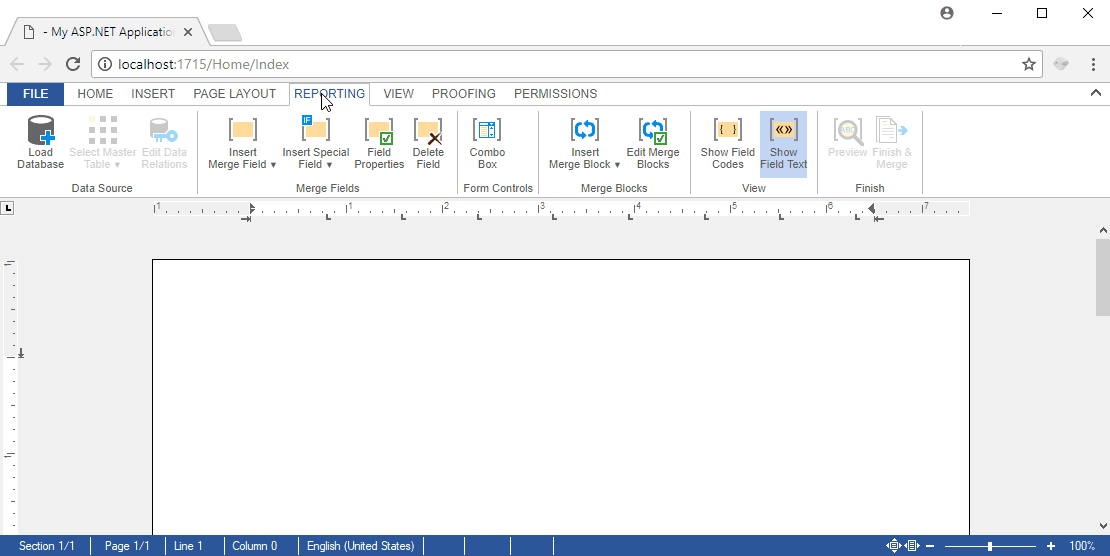This blog post contains outdated information.
The cited code snippets may be workarounds, and be part of the official API in the meantime.
X15: Adding MS Word Compatible Fields and Form Elements to TXTextControl.Web
This article explains how to insert MS Word compatible form fields and form elements to documents.

TX Text Control X15 allows the insertion and manipulation of text fields of type TXText
Javascript: TXText
The following JavaScript code creates and inserts a new merge field into the document at the current input position:
var mergeField = new TXTextControl.MergeField();
mergeField.name = "company_name";
mergeField.text = "«" + mergeField.name + "»";
mergeField.editable = false;
TXTextControl.addMergeField(mergeField);The textFieldEntered event that can be attached using the Javascript: TXText
The following JavaScript code changes the field text when the input position enters the text field:
function textFieldEnteredHandler(e) {
TXTextControl.getTextFields(function (e) {
var currentField = e[0];
currentField.text = "New Field Text";
}, true);
}ApplicationFields are technically all field types that are supported by MS Word including merge fields, content controls and legacy form fields. The following JavaScript code inserts a legacy form drop down field into the TX Text Control:
var comboBox = new TXTextControl.ApplicationField();
comboBox.typeName = "FORMDROPDOWN";
comboBox.parameters = ["w:name w:val=\"Dropdown1\"",
"w:enabled w:val=\"true\"",
"w:calcOnExit w:val=\"false\"",
"w:listEntry w:val=\"Test1\"",
"w:listEntry w:val=\"Test2\""];
comboBox.text = "ComboBox";
comboBox.editable = false;
comboBox.doubledInputPosition = true;
TXTextControl.addTextField(comboBox);In the document, form element fields are represented by their display text (as they would be printed or exported to PDF). All field objects provide a Javascript: TXText
function drawOverlay() {
_divOvr = document.getElementById("divOvr");
var sParams = "";
// create the options based on the drop down items
for (let param of _currentField.parameters) {
if (param.startsWith("w:listEntry")) {
var arrStr = param.split(/["]/);
sParams += "<option>" + arrStr[1] + "</option>";
}
}
// create a new html select object
if (!_divOvr) {
_divOvr = document.createElement("select");
_divOvr.className = "overlay";
_divOvr.id = "divOvr";
_divOvr.innerHTML = sParams;
_container.appendChild(_divOvr);
}
// retrieve the field location in the document
var fldPos = _currentField.bounds.location;
// and calculate the offset location and zoom factor
var x = _textView.offsetLeft + (fldPos.x - _txtViewLoc.x) * _zoom;
var y = _textView.offsetTop + (fldPos.y - _txtViewLoc.y) * _zoom;
// set position and size
_divOvr.style.fontSize = (8 * _zoom) + "pt";
_divOvr.style.zIndex = _textView.style.zIndex + 10;
_divOvr.style.left = x + "px";
_divOvr.style.width = (_currentField.bounds.size.width * _zoom) + "px";
_divOvr.style.minHeight = (_currentField.bounds.size.height * _zoom) + "px";
_divOvr.style.top = y + "px";
// add change event to change text of the field
// when an option has been selected
$('#divOvr').change(function () {
var val = $("#divOvr option:selected").val();
_currentField.text = val;
removeElement();
});
$('#divOvr').focus(function () {
this.selectedIndex = -1;
this.focus();
});
_divOvr.focus();
}The following screen cast shows the inserted drop down box in action. A custom button has been added to a new ribbon group to insert a drop down field.

Try this on your own and download the sample hosted on GitHub.
Also See
This post references the following in the documentation:
TX Text Control .NET Server
- Javascript: TXText
Control.add Event Listener Method - Javascript: TXText
Control.get Text Fields Method - Javascript: TXText
Control. Merge Field Object - Javascript: TXText
Control. Text Field.bounds Property
TX Text Control .NET for Windows Forms
- TXText
Control. Application Field Class
![]()
Download and Fork This Sample on GitHub
We proudly host our sample code on github.com/TextControl.
Please fork and contribute.
Requirements for this sample
- Visual Studio 2015 or better
- TX Text Control .NET Server (trial sufficient)
ASP.NET
Integrate document processing into your applications to create documents such as PDFs and MS Word documents, including client-side document editing, viewing, and electronic signatures.
- Angular
- Blazor
- React
- JavaScript
- ASP.NET MVC, ASP.NET Core, and WebForms
Related Posts
DocumentViewer: Deploying Forms
This sample shows how to deploy a form with form fields using the DocumentViewer in order to collect the completed data.
Sneak Peek X18: Form Field Conditional Instructions
In version X18, we will introduce form fields processing functionality to TX Text Control that allows developers to create and deploy forms.
X18 Outlook: Creating and Completing Forms with TX Text Control
This very early sneak peek shows a new feature that allows the creation and completion of MS Word compatible forms.
X15: Inserting Client-Side Images using JavaScript
Using JavaScript API enhancements, client-side images can be added to documents. This article shows how to add a client-side image using a file input form element.
Introducing TX Text Control 34.0: Your Next Leap in Document Processing.
We are happy to announce the release of TX Text Control 34.0. This version is packed with new features and enhancements that will elevate your document processing experience. This version…






